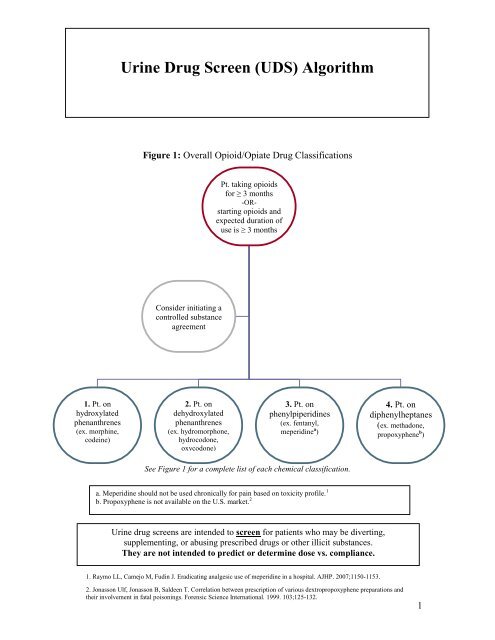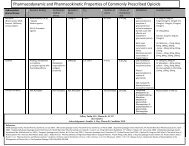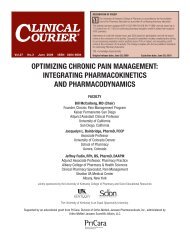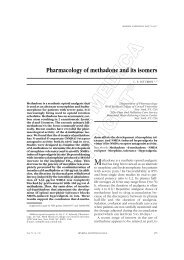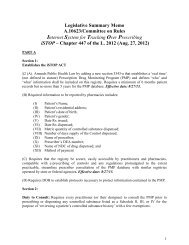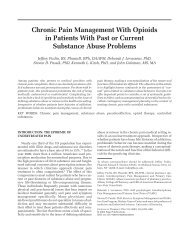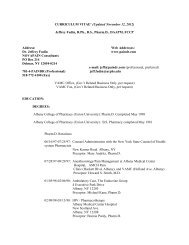Urine Drug Screen (UDS) Algorithm - Dr. Jeffrey Fudin
Urine Drug Screen (UDS) Algorithm - Dr. Jeffrey Fudin
Urine Drug Screen (UDS) Algorithm - Dr. Jeffrey Fudin
Create successful ePaper yourself
Turn your PDF publications into a flip-book with our unique Google optimized e-Paper software.
1. Pt. on<br />
hydroxylated<br />
phenanthrenes<br />
(ex. morphine,<br />
codeine)<br />
<strong>Urine</strong> <strong><strong>Dr</strong>ug</strong> <strong>Screen</strong> (<strong>UDS</strong>) <strong>Algorithm</strong><br />
Figure 1: Overall Opioid/Opiate <strong><strong>Dr</strong>ug</strong> Classifications<br />
Consider initiating a<br />
controlled substance<br />
agreement<br />
2. Pt. on<br />
dehydroxylated<br />
phenanthrenes<br />
(ex. hydromorphone,<br />
hydrocodone,<br />
oxycodone)<br />
Pt. taking opioids<br />
for ≥ 3 months<br />
-OR-<br />
starting opioids and<br />
expected duration of<br />
use is ≥ 3 months<br />
3. Pt. on<br />
phenylpiperidines<br />
(ex. fentanyl,<br />
meperidine a )<br />
See Figure 1 for a complete list of each chemical classification.<br />
a. Meperidine should not be used chronically for pain based on toxicity profile. 1<br />
b. Propoxyphene is not available on the U.S. market. 2<br />
<strong>Urine</strong> drug screens are intended to screen for patients who may be diverting,<br />
supplementing, or abusing prescribed drugs or other illicit substances.<br />
They are not intended to predict or determine dose vs. compliance.<br />
1. Raymo LL, Camejo M, <strong>Fudin</strong> J. Eradicating analgesic use of meperidine in a hospital. AJHP. 2007;1150-1153.<br />
4. Pt. on<br />
diphenylheptanes<br />
(ex. methadone,<br />
propoxyphene b )<br />
2. Jonasson Ulf, Jonasson B, Saldeen T. Correlation between prescription of various dextropropoxyphene preparations and<br />
their involvement in fatal poisonings. Forensic Science International. 1999. 103;125-132.<br />
1
Figure 2: Is your patient a candidate for opioid/opiate medications?<br />
YES<br />
Patient currently uses or has used<br />
illegal substances other than<br />
cannabinoids (including alcohol)<br />
Consider evaluation<br />
by substance abuse clinic<br />
Does patient have recent or<br />
past history of<br />
illegal/recreational drug use?<br />
NO<br />
Patient should NOT be<br />
prescribed opioid<br />
medications<br />
YES<br />
Pt. currently uses or has used<br />
cannabinoids<br />
Is patient willing to discontinue<br />
illicit cannabinoid use?<br />
YES<br />
Obtain a baseline <strong>UDS</strong>;<br />
contact lab for cannabinoid<br />
quantitative confirmation to<br />
aid in future monitoring<br />
Obtain ongoing random <strong>UDS</strong><br />
to monitor opioid and<br />
recreational drug use.<br />
2
(+)<br />
Cannabinoids<br />
Refer to<br />
Figure 1 in this<br />
algorithm<br />
YES<br />
Possible false (+),<br />
request quantitative<br />
confirmation from<br />
laboratory<br />
c. For purposes of this algorithm,<br />
the term “opiate” refers to any<br />
substance either containing or<br />
derived from opium, including<br />
semi-synthetics.<br />
Does patient take prescribed<br />
medications regularly?<br />
What is total dose taken?<br />
(+)<br />
Amphetamines<br />
Does pt. take any agent<br />
that could produce false<br />
(+) result? (See "False<br />
(+)'s for Amphetamines<br />
below)<br />
Monitoring <strong>Urine</strong> <strong><strong>Dr</strong>ug</strong> <strong>Screen</strong>s<br />
Figure 3: Monitoring <strong>UDS</strong> for Morphine/Codeine<br />
NO<br />
Does pt. take OTC products<br />
or substances of abuse (ex.<br />
ephedra, ecstasy/MDMA,<br />
etc)? other)<br />
NO<br />
Request quantitative<br />
confirmation from<br />
laboratory to rule out<br />
amphetamines<br />
Morphine, codeine<br />
(hydroxylated<br />
phenanthrenes)<br />
<strong>UDS</strong> should be<br />
(+) for “opiates” c<br />
(+)<br />
Cocaine<br />
Taper off opioids;<br />
refer to substance<br />
abuse clinic<br />
(+)<br />
Opiates<br />
Expected result;<br />
continue to monitor<br />
for appropriate use<br />
and/or misuse<br />
(-) Serum<br />
Discontinue<br />
morphine<br />
YES<br />
Pt. states he/she is<br />
compliant. Obtain<br />
total dose within<br />
last 48h<br />
Obtain serum<br />
“FREE” morphine<br />
level<br />
(-)<br />
Opiates<br />
Does patient take<br />
medication regularly?<br />
What is total dose taken<br />
within last 48h?<br />
(+) Serum<br />
Compare serum level to<br />
Table 5 in this text<br />
chapter<br />
3<br />
NO<br />
Pt. does not use<br />
regularly. Reevaluate<br />
need for<br />
opiates
Examples of <strong><strong>Dr</strong>ug</strong>s that may Cause False Positives for Amphetamines<br />
(Note: This table is not all inclusive)<br />
Any drug with a catecholamine nucleus:<br />
β-blockers (including propranolol, atenolol, timolol ophthalmic)<br />
β-agonists<br />
Dopamine congeners (ex. levadopa, carbidopa, bupropion)<br />
α-agonist catecholamines [including chronic use of eye drops (Visine®),<br />
nasal decongestants (Afrin®)]<br />
Pseudoephedrine, phenylephrine, ephedra<br />
Adrenergic ophthalmic (ex. dipivefrin, timolol, levobunolol)<br />
NOTE: Methylphenidate will NOT show (+) for amphetamines<br />
4
Figure 4: Monitoring <strong>UDS</strong> for Oxycodone/Hydrocodone/Hydromorphone<br />
PRN<br />
Higher possibility of<br />
(–) <strong>UDS</strong><br />
Re-evaluate daily/weekly<br />
use of oxycodone; adjust<br />
prescription accordingly<br />
(-)<br />
Opiates<br />
Is pt taking "as needed" (PRN) or<br />
around-the-clock (ATC)?<br />
(-) Serum oxycodone<br />
If pt. is (+) for amphetamines or<br />
cannabinoids, consider possible<br />
drug diversion<br />
Discontinue prescribed narcotic<br />
Does patient take regularly?<br />
What is total dose taken within<br />
last 48h?<br />
YES<br />
Obtain qualitative confirmation<br />
(Order a urine oxycodone screen e )<br />
(-) Oxycodone<br />
(Order serum oxycodone)<br />
Hydrocodone, hydromorphone, oxycodone<br />
(dehydroxylated phenanthrenes)<br />
<strong>UDS</strong> for opiates may be (-) or (+)<br />
depending on laboratory cut-off d<br />
ATC<br />
Is the patient's dose<br />
≥80 mg/day?<br />
(+)<br />
Opiates<br />
Expected if total dose ≥ 80mg/d.<br />
Continue to monitor for<br />
appropriate use and/or misuse<br />
(+) Serum oxycodone<br />
Expected result; continue to<br />
monitor for appropriate use<br />
and/or misuse<br />
NO<br />
Higher possibility of<br />
(-) opiate <strong>UDS</strong> in the future<br />
Obtain qualitative confirmation<br />
(Order a urine oxycodone screen e )<br />
(+)<br />
Amphetamines<br />
Refer to Figure 3<br />
5
d. opiate cut-off's vary by laboratory and institution. This algorithm is based on a morphine 300<br />
ng/ml. Laboratory detection thresholds may range from 300 to 2000 ng/mL for morphine).<br />
<strong>Screen</strong>s are calibrated for morphine only, but other phenanthrenes are included by default.<br />
The urine opiate screen will detect other opiates at the following concentrations where a 300ng/mL<br />
cut-off is based on morphine. These may vary by laboratory.<br />
:<br />
Oxycodone 23000 ng/mL<br />
Hydrocodone 1700 ng/mL<br />
Hydromorphone 1700 ng/mL<br />
Oxymorphone 41000 ng/mL<br />
e. <strong>Urine</strong> oxycodone screen detection threshold is 100 ng/ml. This screen offers greater sensitivity<br />
versus the standard urine opiate screen (above) for the detection of oxycodone.<br />
The urine oxycodone screen will detect other opiates at the following concentrations:<br />
Hydrocodone 1562 ng/mL<br />
Hydromorphone 12500 ng/mL<br />
Oxymorphone 1562 ng/mL<br />
Please note: The lower the cut-off, the higher the risk for false (+) results; the higher the cut-off, the<br />
higher the risk for false (–) results.<br />
6
Figure 5: Monitoring <strong>UDS</strong> for Fentanyl<br />
(-)<br />
Fentanyl<br />
Expected result;<br />
Fentanyl is generally not<br />
included in standard <strong>UDS</strong><br />
NO<br />
Suspect patient is taking nonprescribed<br />
opioids<br />
Obtain qualitative confirmation<br />
(Order urine morphine,<br />
oxycodone, hydrocodone,<br />
hydromorphone, buprenorphine<br />
screens)<br />
Any (+) result<br />
Taper opioids;<br />
Refer to CDRP<br />
Fentanyl f<br />
<strong>UDS</strong> has limited utility;<br />
order serum fentanyl level<br />
(+)<br />
Fentanyl<br />
Has patient recently taken any<br />
prescribed short-acting/prn<br />
opioids and/or recreational drugs?<br />
YES<br />
Patient. was prescribed short<br />
acting/prn opioids from another<br />
source<br />
Ask patient for specific<br />
medication, dosage, and prescriber<br />
information<br />
(+)<br />
Amphetamines<br />
See "False Positives for<br />
Amphetamines" above.<br />
YES<br />
Patient admits to recreational drug<br />
use<br />
Taper opioids;<br />
Refer to substance abuse clinic<br />
f. Ordering clinician should be familiar with which<br />
tests are included within their respective<br />
laboratory panels. In some cases fentanyl and/or<br />
methadone may be included.<br />
7
Figure 6: Monitoring <strong>UDS</strong> for Methadone<br />
(–)<br />
Methadone <strong>UDS</strong><br />
Expected result;<br />
continue to monitor for<br />
appropriate use and/or misuse<br />
Methadone g<br />
<strong>UDS</strong> panel may not include methadone h ;<br />
serum levels may also be ordered<br />
Disclaimer: These flow charts are not comprehensive, are not all inclusive, and may not include every<br />
possible permutation presented by the patient. These flow charts are intended as a simple guide and<br />
ordering clinician MUST know which drugs are included in the urine drug screen panel.<br />
References:<br />
1. Chronic Pain Treatment Guidelines. URL available online at:<br />
August 2007 (P: 35-41).<br />
2. Florate Jr, Orlando G. Urinary <strong><strong>Dr</strong>ug</strong> Testing In Pain Management. Practical Pain Management. PPM<br />
Communications, Inc., Glen Mills, PA. April 2005 (P: 38-42).<br />
3. PainEDU.org. <strong>Screen</strong>er and Opioid Assessment for Patients with Pain (SOAPP)®Version 1.0. ©2008<br />
Inflexxion, Inc. URL available online at: http://painedu.org/soapp/SOAPP_24.pdf.<br />
4. Probes, Laerence M. Opioid Blood Levels in Chronic Management. Practical Pain Management. PPM<br />
Communications, Inc., Glen Mills, PA. April 2005 (P: 12-18).<br />
5. Veterans Health Administration, Department of Defense. VA/DoD Clinical Practice Guideline for the<br />
Management of Opioid Therapy for Chronic Pain. Washington (DC): Veterans Health Administration,<br />
Department of Defense; March 2003.<br />
6. Virami, Adil; Mailis, Angela; Shapiro, Lori E; Shear, Neil H. <strong><strong>Dr</strong>ug</strong> Interactions in Human Neuropathic Pain<br />
Pharmacology. © 1997 International Association for the Study of Pain. Pain 73 (1997) 3-13.<br />
Prepared by: <strong>Jeffrey</strong> <strong>Fudin</strong>, B.S., Pharm.D., FCCP<br />
Rev 04/2011<br />
(+)<br />
Methadone <strong>UDS</strong><br />
Refer to Figure 1 in figure 5 in this<br />
algorithm<br />
g. Methadone is CYP 3A4 substrate and is therefore prone to many drug interactions.<br />
h. Some laboratory panels include methadone, but not fentanyl. Methadone <strong>UDS</strong> may be ordered as a<br />
separate test. In some cases fentanyl and/or methadone may be included in the <strong>UDS</strong> panel.<br />
If pt. on ≥ 20mg/d of methadone, urine should remain (+) for 3 days.<br />
Courtesy of <strong>Dr</strong>. <strong>Jeffrey</strong> <strong>Fudin</strong><br />
Special acknowledgements: Riham Ywakim, Pharm.D. and <strong>Dr</strong>. Evan Kujawski, B.A., Pharm.D.<br />
8


